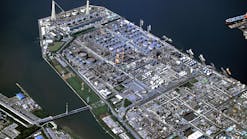Planned maintenance under way at ExxonMobil’s UK refinery
ExxonMobil Corp. is in the process of restarting units following planned maintenance at affiliate Esso Petroleum Co. Ltd.’s (EPCL) 270,000-b/d Fawley refinery and its associated petrochemical complex near Southampton, UK.
An unidentified unit is scheduled for startup on Mar. 11, during which time additional noise may occur at the Fawley site, the operator said in an operations update to the local community.
Restart of the unit was scheduled to begin on Mar. 9, according to a separate community notice.
The announcements followed ExxonMobil’s earlier notification to the community that it would be shutting down some of the processing units at Fawley for about 3 weeks starting on Feb. 27 as part of scheduled maintenance activity.
While the operator did not immediately identify specific works to be executed during the current maintenance shutdown, the company informed the local community in January 2021 that it had submitted planning permission to replace one of the Fawley refinery’s four flares—Flare 4, which was built in the 1960’s and nearing the end of its operational lifecycle—with a new stack to improve operational reliability at the site.
If the flare replacement plan is approved, ExxonMobil Fawley would begin work on foundations during first-half 2021, with the new stack to become operational near yearend 2021, according to project engineer Ryan Worth.
The replacement flare—which would be similar height as the original Flare 4 and use the latest flare-tip technology—would arrive at the Fawley site in four 17.5-m sections predressed with utility lines, ladders, and platforms, Worth said.
Alongside improving operational reliability of the site, the proposed flare replacement aligns with ExxonMobil’s ongoing commitment to safety and environment, as the flare system is critical to the refinery’s safe operation.
During an interruption—such as an unplanned loss of power—that occasionally prevents the Fawley refinery from continuing processing activities, excess hydrocarbon vapors are routed through the flare system, combined with steam, and burned off, ensuring maximum combustion of hydrocarbons and minimizing emissions into the atmosphere, ExxonMobil said.
ExxonMobil also previously took final investment decision to proceed with a more than $1-billion expansion project at Fawley, which aims to reduce diesel imports into the UK by adding a hydrotreating unit—or hydrofiner—to remove sulfur from fuel, supported by a hydrogen plant that, combined, will also help improve the refinery’s overall energy efficiency (OGJ Online, Apr. 24, 2019). In addition to logistics improvements, the project will increase ultralow-sulfur diesel production at the site by 38,000 b/d.
Based on the latest updates from ExxonMobil, the FAST project remains targeted for startup by yearend 2021 (OGJ Online, Nov. 15, 2019).
Situated on the western side of Southampton Water, the Fawley refinery—the UK’s largest—features a mile-long marine terminal that annually handles about 2,000 ship movements and 22 million tonnes of crude and other products.

Robert Brelsford | Downstream Editor
Robert Brelsford joined Oil & Gas Journal in October 2013 as downstream technology editor after 8 years as a crude oil price and news reporter on spot crude transactions at the US Gulf Coast, West Coast, Canadian, and Latin American markets. He holds a BA (2000) in English from Rice University and an MS (2003) in education and social policy from Northwestern University.



